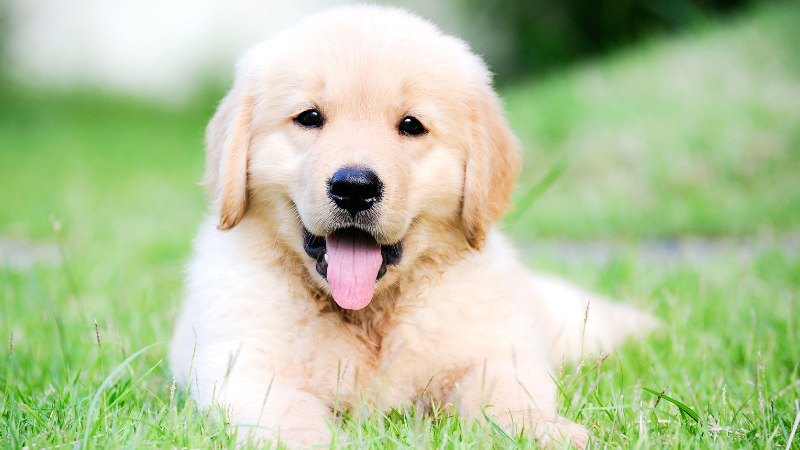When Do Dogs Stop Growing? – The Definite Answer (Explaining Weekly Growth Rate of All Dog Types)

Dogs are among the most popular pets in the world, and their owners frequently wonder: “When do dogs stop growing?”
Knowing your furry friend’s expected maturity period will allow you to offer the best care and nourishment as they grow into adulthood.
Unfortunately, this question has no universal answer because various dog breeds develop at different rates. Also, male dogs will grow earlier than female dogs. In this article, we’ll examine how dogs grow and when they stop growing depending on their size categories.
When Do Small Dog Breeds Stop Growing?
The average weight of a smaller breed (whether purebred dogs or mixed breed dogs) is under 20-22 pounds, and they reach their full size quite quickly—usually by the time they are a year old. Chihuahuas, for instance, one of the smallest breeds, often reach their full size by the time they are six months old.
On the other hand, several other toy breeds, such as the Shih Tzu or the Pekingese, may continue to develop their adult stature up to the age of 18 months.
Although small breed dogs achieve their adult size earlier, it is essential to remember that they still need the appropriate amount of food and activity to keep their health in good condition.
Small dog breeds are more likely to be overweight, which can result in various health problems. As a result, it is necessary to supply them with a nutritionally balanced diet and regular physical activity.
When Do Medium Dog Breeds Stop Growing?
Medium-breed puppies often achieve their full size (23–56 pounds) between the ages of one and two.
Certain dog breeds, such as the Beagle and the Cocker Spaniel, achieve their full size around the time they are 12 months old, while others, such as the Australian Shepherd and the Border Collie, may continue to grow until they are two years old.
You must a huge amount of lot A food that is rich in nutrients is also essential since it will assist in guaranteeing that your dog develops into a robust adult.
In addition, because medium dog breeds are predisposed to have joint problems, you must ensure that you provide them with joint supplements or food that promotes healthy joints.

When Do Large Breed Dogs Stop Growing?
The majority of larger dog breeds, which normally weigh between 57 and 99 pounds, achieve their full size between the ages of 18 months and two years of age.
Certain larger puppy breeds or large dogs, such as the Labrador Retriever and the Boxer, achieve their full size at roughly 18 months, while others, such as the German Shepherd and the Doberman Pinscher, may take up to two years.
Because larger breeds or large breed puppies mature more deliberately than small dogs and medium dog breeds, they have unique dietary requirements to accommodate their maturation.
Also, large puppies require a diet that is both nutritious and well-balanced, with a greater protein content to assist the building of muscle and a higher calcium-to-phosphorus ratio in encouraging the formation of strong bones.
In addition, keeping a close eye on their workout routine is essential to prevent placing excessive pressure on their joints.

When Do Giant Dog Breeds Stop Growing?
Giant breed puppies that weigh more than 100 pounds require the greatest amount of time to mature into their maximum size. In most cases, they will continue to develop normally until they are between the ages of two to three years.
Giant adult dogs, like the Mastiff, may stop growing at the age of two, while others, like the Great Dane and Saint Bernard, may take up to three years to attain their maximum size.
Giant dog breeds have unique dietary needs that must be met in order to ensure healthy development and proper joint growth throughout their lives.
In order to promote the growth of their muscles and bones, they require a diet that is rich in protein, calcium, and several other necessary elements.
In addition, you should keep a close eye on their workouts to ensure that they are not placing excessive pressure on their joints since they are prone to developing joint problems.
Puppy Growth Rate Chart
Here is a puppy growth chart table (according to their respective age) for small, medium, large, and giant breeds:
Small Breeds
| Age (Weeks) | 1 |
| Weight (lbs) | 0.5-1 |
| Height (inches) | 2-3 |
| Age (Weeks) | 2 |
| Weight (lbs) | 1-2 |
| Height (inches) | 3-5 |
| Age (Weeks) | 3 |
| Weight (lbs) | 2-3 |
| Height (inches) | 4-6 |
| Age (Weeks) | 4 |
| Weight (lbs) | 3-4 |
| Height (inches) | 5-7 |
| Age (Weeks) | 5 |
| Weight (lbs) | 4-6 |
| Height (inches) | 6-8 |
| Age (Weeks) | 6 |
| Weight (lbs) | 6-8 |
| Height (inches) | 7-9 |
| Age (Weeks) | 7 |
| Weight (lbs) | 8-10 |
| Height (inches) | 8-10 |
| Age (Weeks) | 8 |
| Weight (lbs) | 10-12 |
| Height (inches) | 9-11 |
| Age (Weeks) | 9 |
| Weight (lbs) | 12-14 |
| Height (inches) | 10-12 |
| Age (Weeks) | 10 |
| Weight (lbs) | 14-16 |
| Height (inches) | 10-13 |
| Age (Weeks) | 11 |
| Weight (lbs) | 16-18 |
| Height (inches) | 11-14 |
| Age (Weeks) | 12 |
| Weight (lbs) | 18-20 |
| Height (inches) | 11-15 |
Medium Breeds
| Age (Weeks) | 1 |
| Weight (lbs) | 1-3 |
| Height (inches) | 3-5 |
| Age (Weeks) | 2 |
| Weight (lbs) | 3-5 |
| Height (inches) | 5-8 |
| Age (Weeks) | 3 |
| Weight (lbs) | 5-8 |
| Height (inches) | 7-10 |
| Age (Weeks) | 4 |
| Weight (lbs) | 8-10 |
| Height (inches) | 9-12 |
| Age (Weeks) | 5 |
| Weight (lbs) | 10-15 |
| Height (inches) | 10-13 |
| Age (Weeks) | 6 |
| Weight (lbs) | 15-20 |
| Height (inches) | 11-15 |
| Age (Weeks) | 7 |
| Weight (lbs) | 20-25 |
| Height (inches) | 12-16 |
| Age (Weeks) | 8 |
| Weight (lbs) | 25-30 |
| Height (inches) | 12-17 |
| Age (Weeks) | 9 |
| Weight (lbs) | 30-35 |
| Height (inches) | 13-18 |
| Age (Weeks) | 10 |
| Weight (lbs) | 35-40 |
| Height (inches) | 13-19 |
| Age (Weeks) | 11 |
| Weight (lbs) | 40-45 |
| Height (inches) | 14-20 |
| Age (Weeks) | 12 |
| Weight (lbs) | 45-50 |
| Height (inches) | 14-21 |
Large Breeds
| Age (Weeks) | 1 |
| Weight (lbs) | 3-5 |
| Height (inches) | 5-7 |
| Age (Weeks) | 2 |
| Weight (lbs) | 5-10 |
| Height (inches) | 7-10 |
| Age (Weeks) | 3 |
| Weight (lbs) | 10-15 |
| Height (inches) | 9-12 |
| Age (Weeks) | 4 |
| Weight (lbs) | 15-20 |
| Height (inches) | 11-14 |
| Age (Weeks) | 5 |
| Weight (lbs) | 20-30 |
| Height (inches) | 12-16 |
| Age (Weeks) | 6 |
| Weight (lbs) | 30-40 |
| Height (inches) | 14-18 |
| Age (Weeks) | 7 |
| Weight (lbs) | 40-50 |
| Height (inches) | 15-20 |
| Age (Weeks) | 8 |
| Weight (lbs) | 50-60 |
| Height (inches) | 16-22 |
| Age (Weeks) | 9 |
| Weight (lbs) | 60-70 |
| Height (inches) | 17-23 |
| Age (Weeks) | 10 |
| Weight (lbs) | 70-80 |
| Height (inches) | 18-24 |
| Age (Weeks) | 11 |
| Weight (lbs) | 80-90 |
| Height (inches) | 19-25 |
| Age (Weeks) | 12 |
| Weight (lbs) | 90-100 |
| Height (inches) | 20-26 |
Giant Breeds
Here is the growth table for giant breed pups:
| Age (Weeks) | 1 |
| Weight (lbs) | 5-10 |
| Height (inches) | 8-10 |
| Age (Weeks) | 2 |
| Weight (lbs) | 10-20 |
| Height (inches) | 10-14 |
| Age (Weeks) | 3 |
| Weight (lbs) | 20-30 |
| Height (inches) | 12-16 |
| Age (Weeks) | 4 |
| Weight (lbs) | 30-40 |
| Height (inches) | 14-18 |
| Age (Weeks) | 5 |
| Weight (lbs) | 40-50 |
| Height (inches) | 16-20 |
| Age (Weeks) | 6 |
| Weight (lbs) | 50-65 |
| Height (inches) | 18-22 |
| Age (Weeks) | 7 |
| Weight (lbs) | 65-80 |
| Height (inches) | 20-24 |
| Age (Weeks) | 8 |
| Weight (lbs) | 80-95 |
| Height (inches) | 22-26 |
| Age (Weeks) | 9 |
| Weight (lbs) | 95-110 |
| Height (inches) | 24-28 |
| Age (Weeks) | 10 |
| Weight (lbs) | 110-125 |
| Height (inches) | 26-30 |
| Age (Weeks) | 11 |
| Weight (lbs) | 125-140 |
| Height (inches) | 28-32 |
| Age (Weeks) | 12 |
| Weight (lbs) | 140-160 |
| Height (inches) | 30-34 |
Factors Affecting Puppy Growth
Throughout their first year of life, puppies experience great development and change. They go through a fast growth and development period from the moment they are born until they mature into adults.
Nevertheless, the rate at which a puppy grows can be affected by several factors, including genetics, poor diet, physical activity, and health problems. Let’s discuss how various factors affect puppy growth.
Genetics
The rate at which a puppy will mature is mostly determined by its genes/breed makeup. Their breed, size, and parents impact the pace at which a puppy grows and matures.
For instance, little dog breeds are more likely to develop and mature quickly than large dog breeds. Similarly, certain breeds can have growth spurts at certain points in their development.

Exercise
To properly nourish their developing pup bodies, puppies require significant playtime and exercise. They are better able to grow strong muscles and bones, and they are also better able to maintain a healthy weight when they exercise regularly.
On the other hand, excessive activity or exercise that is excessively taxing on a puppy’s body might be detrimental to its growth and development. You must engage in age-appropriate but not overly strenuous physical activity with your puppy.
Nutrition
A puppy’s diet is extremely important to its overall growth and development. To sustain their rapidly expanding bodies, they require pet food that is abundant in protein, vitamins, and minerals.
It is necessary to provide your new puppy with a diet of high-quality puppy food tailored to its specific breed and size.
Obesity and other health problems can develop in a puppy if the owner overfeeds it or provides the dog bed with a portion of food that is not properly balanced for the animal.
If you want help determining the best possible diet for your dog’s life here, this dog food advisor may help.
Health Issues
Growth and development are not the only things a puppy’s health can impact. Problems with growth can be caused in pups by a wide range of diseases, including hypothyroidism and cardiac abnormalities.
In addition, parasites like worms might hinder a puppy’s capacity to absorb nutrients from its diet, ultimately impeding its growth.
Your puppy should regularly visit the veterinarian for checkups so that any potential health problems may be identified and treated promptly.

Environmental Factors
Various environmental conditions can influence a puppy’s growth, including temperature, humidity, and even stress.
Puppies must be kept in a warm and comfortable environment so the long bones and their developing bodies may thrive.
Their appetites can be negatively impacted, leading to issues with their growth if they are exposed to environmental stresses such as high temperatures.
Here you can also find all the other factors that affect the pup’s growth and development.
How can I estimate the size my new puppy will reach as it matures?
In order to estimate how large your puppy’s paws will become as it gets older, it is necessary to consider several aspects, such as its breed, gender, age when it was desexed, nutrition, and amount of exercise.
Although the size of the puppy’s paw cannot be used as a reliable indicator of the adult size, some equations can be used to estimate adult weight depending on the age and weight of the puppy.
One such method involves taking the puppy’s weight in pounds at a specific age, dividing it by their age in weeks, and multiplying the result by 52, which is the number of weeks in a year.
This method may be used to estimate the puppy’s adult size. Even so, this algorithm may not always produce precise results, and the size of the puppy’s parents can also provide a decent estimate of their eventual size.
It is essential to ensure that your puppy receives the appropriate diet and gets plenty of exercise throughout their development to prevent obesity and other health problems.

Is it possible to determine the mature size of your puppy using DNA testing?
Certain DNA tests claim to predict your puppy’s adult size based on its genetic markers.
However, the accuracy of these predictions can vary, and your puppy’s mature size can also be affected by other factors, such as the nourishment it receives, the amount of exercise it gets, and the age at which it is neutered.
It is vital to remember that these tests do not always provide reliable results, and there is no alternative to tracking your puppy’s progress in terms of both size and development over time.
In addition, estimating how big your puppies grow can be useful for making plans, but the most important thing you can do for your next furry friend or companion is to make sure they receive the right care and attention they need, regardless of how big they are.
Here you can find more about DNA testing’s role in a dog’s growth and development.
Conclusion
The answer to the question “When do dogs stop growing?” changes depending on the dog’s breed as well as the size of the dog.
In general, small breeds attain their full size by the time they are one year old, medium and large breeds by the time they are two years old and giant breeds are fully grown by the time they are three years old.
It is essential to ensure that your dog receives the appropriate diet and activity while they are still young in order to promote their development and guarantee that they will mature into healthy and strong adults.
